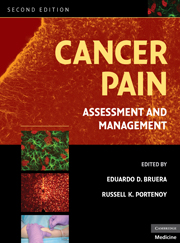Book contents
- Frontmatter
- Contents
- Contributors
- Preface
- SECTION I MECHANISMS AND EPIDEMIOLOGY
- SECTION II EPIDEMIOLOGY AND SYNDROMES
- SECTION III ASSESSMENT
- SECTION IV PHARMACOLOGICAL TREATMENT
- SECTION V OTHER INTERVENTIONAL STRATEGIES
- SECTION VI REHABILITATION AND PSYCHOLOGICAL INTERVENTIONS
- SECTION VII THE ROLE OF ANTINEOPLASTIC THERAPIES IN PAIN CONTROL
- SECTION VIII PAIN IN SPECIAL POPULATIONS
- SECTION IX DIFFICULT PAIN PROBLEMS
- 25 Cancer pain and depression
- 26 Neuropathic pain
- 27 Breakthrough pain
- 28 Bone pain
- SECTION X SYSTEMS OF CARE
- Index
- Plate section
- References
26 - Neuropathic pain
from SECTION IX - DIFFICULT PAIN PROBLEMS
Published online by Cambridge University Press: 06 July 2010
- Frontmatter
- Contents
- Contributors
- Preface
- SECTION I MECHANISMS AND EPIDEMIOLOGY
- SECTION II EPIDEMIOLOGY AND SYNDROMES
- SECTION III ASSESSMENT
- SECTION IV PHARMACOLOGICAL TREATMENT
- SECTION V OTHER INTERVENTIONAL STRATEGIES
- SECTION VI REHABILITATION AND PSYCHOLOGICAL INTERVENTIONS
- SECTION VII THE ROLE OF ANTINEOPLASTIC THERAPIES IN PAIN CONTROL
- SECTION VIII PAIN IN SPECIAL POPULATIONS
- SECTION IX DIFFICULT PAIN PROBLEMS
- 25 Cancer pain and depression
- 26 Neuropathic pain
- 27 Breakthrough pain
- 28 Bone pain
- SECTION X SYSTEMS OF CARE
- Index
- Plate section
- References
Summary
Introduction
Effective pain management in patients with cancer is an essential component of care during active treatment, as well as in palliative and end-of-life care. Chronic pain occurs frequently in patients with cancer, with an estimated prevalence that ranges from 40% to 60%. Pain may be caused by direct tumor infiltration of neural structures or by treatment sequelae. Although the prevalence of pain in the outpatient setting is 20%–40%, it may rise to 80% for patients at the end of life. However, several prospective studies suggest adequate pain control could be achieved in 90% of patients by following the World Health Organization guidelines.
Because pain is ultimately a perceptual construct within the central nervous system (CNS), a patient's experience of pain is a result of complex somatosensory processing. Developing understanding of the physiological and biochemical processes involved in pain, combined with an appreciation of the cognitive, emotional, and cultural framework of the patient offers the best opportunity to provide treatment of underlying mechanisms and relief of suffering.
Even though most patients initially report somatic or visceral pain, they also frequently experience painful neuropathic components. Management of neuropathic pain presents a number of challenges, because it is often more resistant to conventional analgesic approaches. Mixed pain problems, in which neuropathic pain is combined with elements of somatic or visceral pain, are also common. Neuropathic pain may also signal progressive and often incurable disease.
- Type
- Chapter
- Information
- Cancer PainAssessment and Management, pp. 478 - 505Publisher: Cambridge University PressPrint publication year: 2009



